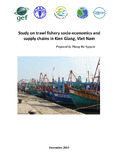Study on Trawl Fishery Socio-Economics and Supply Chains in Kien Giang, Viet Nam
抄録
This study on the socio-economics and supply chain of trawl fisheries in Kien Giang province, Viet Nam, was conducted during November and December 2015, and focused on otter trawler fleets, shrimp trawlers, anchovy pair trawlers and mixed pair trawlers in Rach Gia city, Chau Thanh district and Ha Tien Township. Questionnaires were designed to interview and get feedback and relevant information from fishers, vessel owners, middlemen, seafood/fishmeal processors and traders, associations and fisheries managers. The main objectives of the study are to identify: (1) the key issues related to socio-economics of the trawl fishery in Kien Giang including catch and catch composition, catch volume and value, role of main fish production in the fishery concerned; (2) issues related to fishing operation and post-harvest handling practices; (3) importance of the trawl fishery in terms of food security, livelihoods and incomes of stakeholders who may be directly or indirectly impacted by the fishery and; (4) issues related to management of the fishery.
The study focused on social aspects such as the number of fishermen and associated labourers in the fishery; and the incomes and livelihoods of major groups (fishers, vessel owners, fish porters, fish pickers, workers in the fishmeal processing plants, seafood processing factories). Analysis of trends in catch landings of the important fishing fleets in recent years and rough estimations of some other indicators for the fishing fleets concerned (e.g. trip revenue, trip operational cost and net benefit) was performed based on the data and information collected. Assessments of the key supply chains for the major products caught by trawlers such as pig fish/fertilizer fish,1 dried squid, octopus and cuttlefish, shrimp, were carried out.
The trawl fishery plays an important role in terms of socio-economic development in the province, and annually contributes about 85 percent of the total landing volume, as well as providing work for about 27 500 fishers, as well as a larger number of labourers involved in fishmeal processing, seafood processing and sun-drying shrimp, and fish porters at the landing sites and fishing ports. Additionally, the fishery supplies important sources of raw materials for the fishmeal industry in the Province as well as throughout South Viet Nam. In 2015, about 110 000 tonnes of fishmeal was produced in the province which is important ingredient of the aquaculture feed for shrimp and other fish species farmed in the country and a part was used for export.
However, the fishery is faced with issues that may impact on its sustainability and these challenges and difficulties must be addressed to ensure a long-term sustainable fishery. Such issues currently include: weak management of fishing labourers, increasing conflicts with other fishing fleets, poor fishing and handling practices, and weak monitoring, control and surveillance (MCS). The increasing demand on raw materials for fishmeal industry and seafood for human consumption create more challenges to the sustainability of the fishery.
This study also emphasized current fisheries management bodies at the local level and management policies and strategies at both the central and local levels. The central government has recognized that trawl fishing capacity should be reduced and have developed a roadmap to decrease the number of trawlers in the coming years. This also involves a freeze on the quantity of small trawlers (below 90 HP). Additionally, the study shows that it is difficult to persuade trawler operators to change to other gears, because trawl fishers are still able to stay in business with positive benefits.
There is a need to improve the trawl fishery in Kien Giang towards sustainability to ensure security for the large number of beneficiaries who have either direct or indirect benefits from the fishing operations. Collective efforts should be made among relevant stakeholders and actors along the key supply chains of the products sourced by this important fishery.
While the information collected from the study is informative and valuable, the limitations of the study duration and coverage should be taken into consideration when using the results. An in-depth study on the socio-economics of trawl fishery and other gear types should be performed to fulfill the gaps and to keep track of the trends. Nevertheless, the outputs of the study are useful as baseline for later comparison and valuable for reference purposes.
Citation
Ba Nguyen, T. (2015). Study on Trawl Fishery Socio-Economics and Supply Chains in Kien Giang, Viet Nam. Training Department, Southeast Asian Fisheries Development Center.
Collections
- Country Activities [95]

